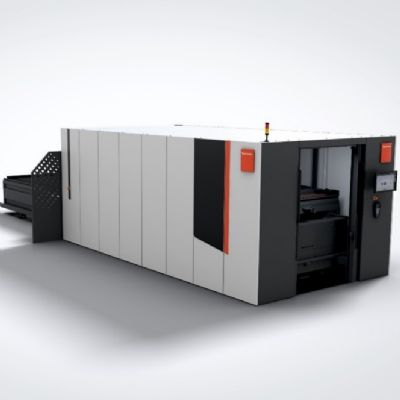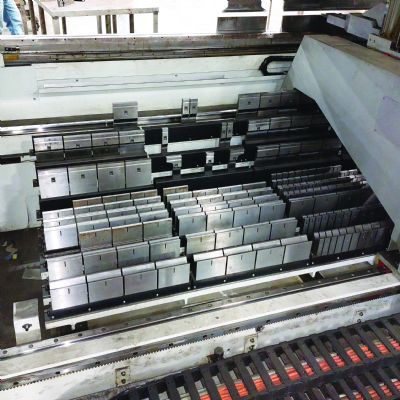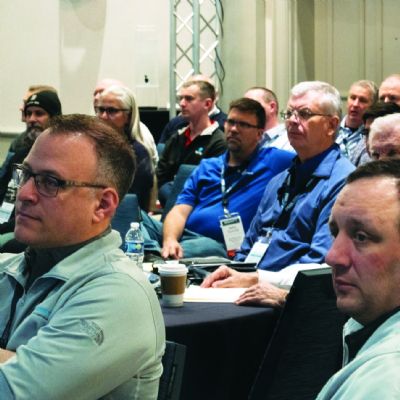In the early 1990s, Nelson Steel Products began investing in robotic welding, and now the company boasts more than a dozen robotic welding cells. Then management saw potential in laser cutting technology, which resulted in a relationship with Mazak that continues to this day. Nelson Steel Products bought its first flat sheet laser cutting machine, a Mazak model, in the mid-1990s, and followed with another a couple years later. Around the same time came investment in press brakes, starting with mechanicals and then hydraulic models, and most recently, an electric press brake. During the pandemic, the company integrated a robot to tend one of its press brakes.
Via its varied machinery, the company processes roughly 80 percent mild steel along with some stainless steel and aluminum, in thicknesses to ⅝ in.
Loading/Unloading and Storage for Ever-Quicker Machines
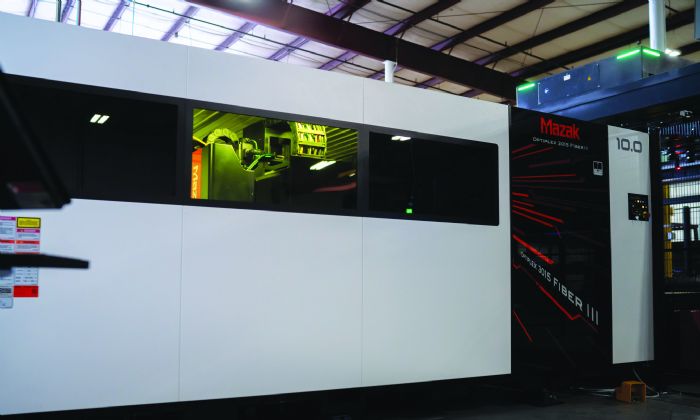 As we can see, Nelson Steel Products is quick to adopt and expand on certain technologies, and add automation to optimize productivity. A dive into the company’s laser cutting evolution, including related material handling automation, drives the point home. Those first two laser cutting machines mentioned above, 1- and 2-kW CO2 models, had no surrounding automation, Ryzenga reports.
As we can see, Nelson Steel Products is quick to adopt and expand on certain technologies, and add automation to optimize productivity. A dive into the company’s laser cutting evolution, including related material handling automation, drives the point home. Those first two laser cutting machines mentioned above, 1- and 2-kW CO2 models, had no surrounding automation, Ryzenga reports.
“We loaded and unloaded the machines by hand, with them stopped,” he recalls.
Laser cutting with automation at the firm arrived in 2011, in the form of a Mazak Model HTX 4-kW CO2 machine equipped with a flexible manufacturing system (FMS). The FMS consists of a storage tower to store and retrieve sheets of various specifications, pneumatic loading for positioning of sheets onto the cutting bed, and automatic unloading. With raw material loaded into towers, complete operation to finished part requires little to no labor, according to Mazak officials, who note that the high FMS capacity allows for unattended production throughout shifts and over weekends.
“This took us to the next level,” Ryzenga says.
In 2018, the company installed a Mazak STX 3-kW fiber laser cutting machine and fit it into the FMS, thus developing a two-machine automated cutting cell.
Nelson Steel Products then began its ascent into higher-power laser cutting in 2020 with a 10-kW Mazak OptiPlex 3015 fiber-laser machine, and added another of the same in 2022. Both of these units feature gantry-robot loading/unloading automation, one with a material-storage tower, the other without. Bringing in the 10-kW machines has allowed for cutting of some sheet gauges at five times the speed of cutting on the 4-kW machine, according to Ryzenga, so automation becomes a must to keep material moving.
“Now all of our flat-sheet laser cutting machines—the 3- and 4-kW machines and the two 10-kW machines—have automation,” he says. “We switch through multiple gauges of steel every day on those laser cutting machines, so we try to batch jobs with the same material thicknesses. The towers really help with organizing all of that—switching out gauges and having access to all of our material while saving floor space.”
Once offloaded, laser-cut sheets are stacked near deburring and other secondary operations for manual part removal and sorting, which doesn’t impede cutting production.
“We’d love to automate part sorting, but in our production setting—cutting sheet thin to thick, and producing parts as small as 1 by 1.5 in. to some that may run almost a full 60 by 120-in. sheet—finding automation that can adapt or handle such a variety of nests is difficult. If we had more consistent products, then yes, I can see bringing in that automation. But I just don’t think part-sorting automation is quite there for us yet.”
And, the addition of static sheet-storage racks, from Michigan-based Big Steel Rack, efficiently store reserve sheet material vertically, where previously it had been scattered across the shop floor. In fact, this racking freed up enough floor space to bring in the first 10-kW laser cutting machine and automation, according to Ryzenga.
Automation Pays Off Throughout
Capacity, throughput and labor all led to the decision to add automated material handling to Nelson Steel Products’ welding and press brake cells, according to Ryzenga.
“At first, it was difficult to justify on paper the cost of automation, but we knew that the industry was moving in this direction,” he says. “We at least wanted to get into the learning curve of automation ahead of time.”
While Nelson Steel Products typically works with automation integrators, over time it has developed inhouse knowledge and expertise in planning, operating and maintaining such automation. Ryzenga cites another automation example apart from laser cutting, in welding operations, where inhouse integration and implementation has paid off.
“In 2017, we had a big job where the final operation after robotic welding of subassemblies required additional manual welding due to complexity and part size,” he says. “Our customer wanted us to increase throughput, but we were maxed out. With our customer we looked closely at the final manual operation. Ultimately, with the customer picking up some tooling costs as we purchased a robot, we arrived at an automation solution that increased throughput by 30 percent and freed four of seven employees from this operation for other work.
“Automation has never eliminated any jobs here,” Ryzenga continues. “It allows us to shift operators to other jobs where they’re needed. And it removes the monotony and potential for injury on a lot of these jobs.”
Automation buy-in, a possible sticking point, never has been a problem at Nelson Steel Products, according to Ryzenga, once employees realize the benefits.
“We’ve had many operators of laser cutting machines come here, and their previous jobs didn’t include automated loading/unloading operations and things like that,” he explains. “They had to perform the work the old-school way. They’re happy to be rid of that work and automation adds to their skill set. Honestly, automation has helped us attract employees.” MF
See also: Mazak Optonics Corporation, Cincinnati Inc., Remmert GmbH
Technologies: Bending, CNC Punching, Cutting
 Lou Kren
Lou Kren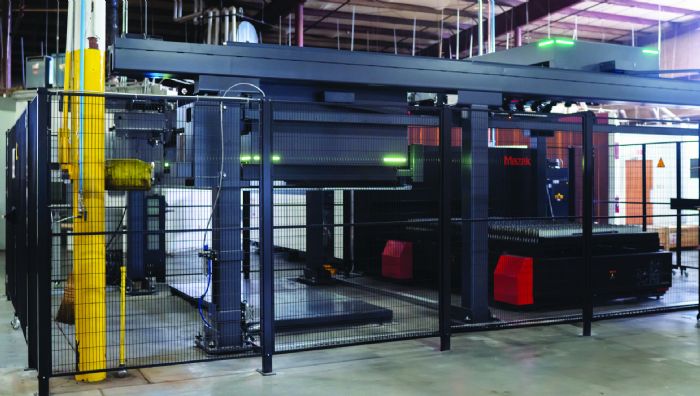 Fast forward to fall of 2023, when MetalForming took a hands-on look at what now is a single source for complete metal fabrication, including robotic welding, laser sheet and tube cutting, and assembly and packaging. Investment in automation, particularly for welding, machine tending and material handling, helps Nelson Steel Products ably serve a diverse customer set, including those in office furniture, agricultural and outdoor power equipment, and commercial floor cleaning. Three buildings—two adjoining and one about a half-mile away—total 150,000 sq. ft. of manufacturing space under roof, where 110 employees work across two shifts.
Fast forward to fall of 2023, when MetalForming took a hands-on look at what now is a single source for complete metal fabrication, including robotic welding, laser sheet and tube cutting, and assembly and packaging. Investment in automation, particularly for welding, machine tending and material handling, helps Nelson Steel Products ably serve a diverse customer set, including those in office furniture, agricultural and outdoor power equipment, and commercial floor cleaning. Three buildings—two adjoining and one about a half-mile away—total 150,000 sq. ft. of manufacturing space under roof, where 110 employees work across two shifts.





 As we can see, Nelson Steel Products is quick to adopt and expand on certain technologies, and add automation to optimize productivity. A dive into the company’s laser cutting evolution, including related material handling automation, drives the point home. Those first two laser cutting machines mentioned above, 1- and 2-kW CO2 models, had no surrounding automation, Ryzenga reports.
As we can see, Nelson Steel Products is quick to adopt and expand on certain technologies, and add automation to optimize productivity. A dive into the company’s laser cutting evolution, including related material handling automation, drives the point home. Those first two laser cutting machines mentioned above, 1- and 2-kW CO2 models, had no surrounding automation, Ryzenga reports.